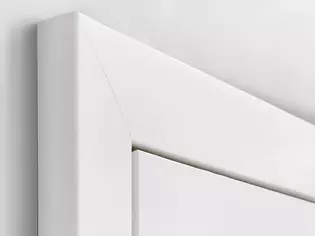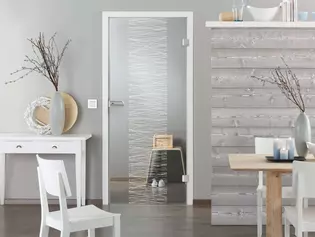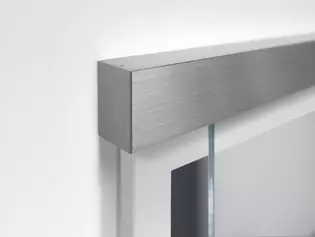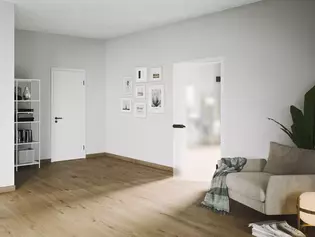The door frame parade
Door frames connect the door leaf and the wall. Here you can find out what they are made of, what types there are and how expensive door frames are.

What are door frames?
Door frames are also colloquially referred to as door frames. A door frame is the immovable part of the door, which frames the wall in the area of the door opening, as well as completely or partially covers the sides of the door reveal. By reveal is meant the inner surface of the wall in the area of the opening. In very simplified terms, the door frame forms a frame around the open area in the wall where the door is inserted.
Thus, a frame is not only the foundation of a good door - it also contributes to the aesthetics of the room. The design of the door leaf and the door frame should therefore be visually coordinated.
What is a frame made of?
Frames are usually made of wood or wood-based materials. For fire protection or security doors, frames can also be made of steel or aluminum. As a rule, the frame is made of the same material as the door leaf, but it can also be different: Glass doors, for example, usually have a frame made of metal or wood.Frames are usually made of wood or wood-based materials. For fire protection or security doors, frames can also be made of steel or aluminum. As a rule, the frame is made of the same material as the door leaf, but it can also be different: Glass doors, for example, usually have a frame made of metal or wood.

What technical benefit does the frame offer?
In the case of swing doors, the door frame is used to hold the door hinges. These are connected to the door leaf and attached to the so-called frame leg. The hinge function allows the door leaf to be rotated so that the door opens and closes. In addition, the frame bears the weight of the door leaf via the door hinges.
In the case of single-leaf doors, the strike plate is anchored in the opposite side of the frame. This refers to the openings in which the lock latch or lock bolt engages when closing.
There are also frame models with a circumferential rebate - a step-shaped recess. The door leaf fits exactly into this recess, so that the door closes particularly tightly. In some cases, plastic seals are even installed in the frame rebate, which allow the door to close particularly quietly or almost airtight.
What are the types of door frames?
Whether perimeter frame, corner frame, through frame, block frame or frame frame - all these door frames are mainly used for doors in masonry or concrete walls. For lightweight walls in drywall construction, special stud frames are used. We explain the different types of door frames.
Surrounding frame
The perimeter frame is most often installed in German buildings. It covers the entire door reveal, forming a frame around the door opening on both sides. On the side where no door is installed, it is a decorative frame: this frame has no technical functional use, but only provides a coherent image. After all, a doorway with a half-sided frame would look strange. In addition, the perimeter frame protects the corners of the wall. It is suitable for both masonry and stud walls.
Block frame
The block frame can be found mainly in office buildings. It represents a reduced, no-frills form of door frames. The block frame is inserted and fixed in the door reveal. Unlike the perimeter frame, the step between the wall and the frame is not visible. In other words, the block frame does not enclose the wall opening, but fills the reveal in its entire width. At the same time, it closes flush with the wall, which is why there is no frame around the door leaf. Simplified: the block frame covers the wall opening only on the inside.
A special form of the block frame is the stick frame. It does not have a frame and does not cover the entire door opening. However, it is mounted in the middle of the reveal and does not fill the entire width of the reveal.
Frame for blinds
Als Gegenstück zur Blockzarge greift die Blendrahmenzarge überhaupt nicht in die Laibung ein. Ganz im Gegenteil: Sie verblendet nur die Wandöffnung und ist daher vor ihr befestigt. Vereinfacht gesagt: Die Blendrahmenzarge deckt die Wandöffnung nur außen ab. Meist wird sie in der Wand verdübelt. Die Blendrahmenzarge eignet sich daher besonders für kleine Maueröffnungen, da der Blendrahmen bei breiten und schmalen Wandstärke gleichermaßen montiert werden kann.
Passageway frame
The through frame takes aesthetic utility to the extreme, as it is a purely ornamental frame. Passage frames have no technical necessity. Although they protect the wall from mechanical damage - but they are mounted only on wall openings in which no door is inserted. Thus, this door frame should only attractively disguise the opening or passage.
Corner frame
The corner frame, unlike the through frame, is a purely functional frame. It is mounted directly on the corner of the wall. It is used where the wall reveal is too small or too deep for a perimeter frame. Moreover, the corner frame does not interfere much with the reveal, as it covers the wall opening only on one side of the door leaf. This door frame is used where appearance must give way to functionality, e.g. in storage rooms or in the basement.

Sliding doors: with or without door frame?
Sliding doors - whether integrated into the wall or running in front of it - also need a door frame, because the wall opening should not be visible. For sliding doors, we distinguish between visible and invisible frames: the latter is called a "frameless sliding door system". A visible frame for a wall-integrated sliding door makes sense, for example, if several swing doors are installed in the room and the sliding door should integrate into the room design.
What is the cost of room doors with frame?
The price of a door frame varies depending on various factors: material of the frame, material of the door leaf, type of frame, filling of the door leaf, type of door, type of surface sealing, additional design elements, dimensions, etc. For more information on the various forms of doors, see our articles on the subject of "room doors" and "door leaves".
